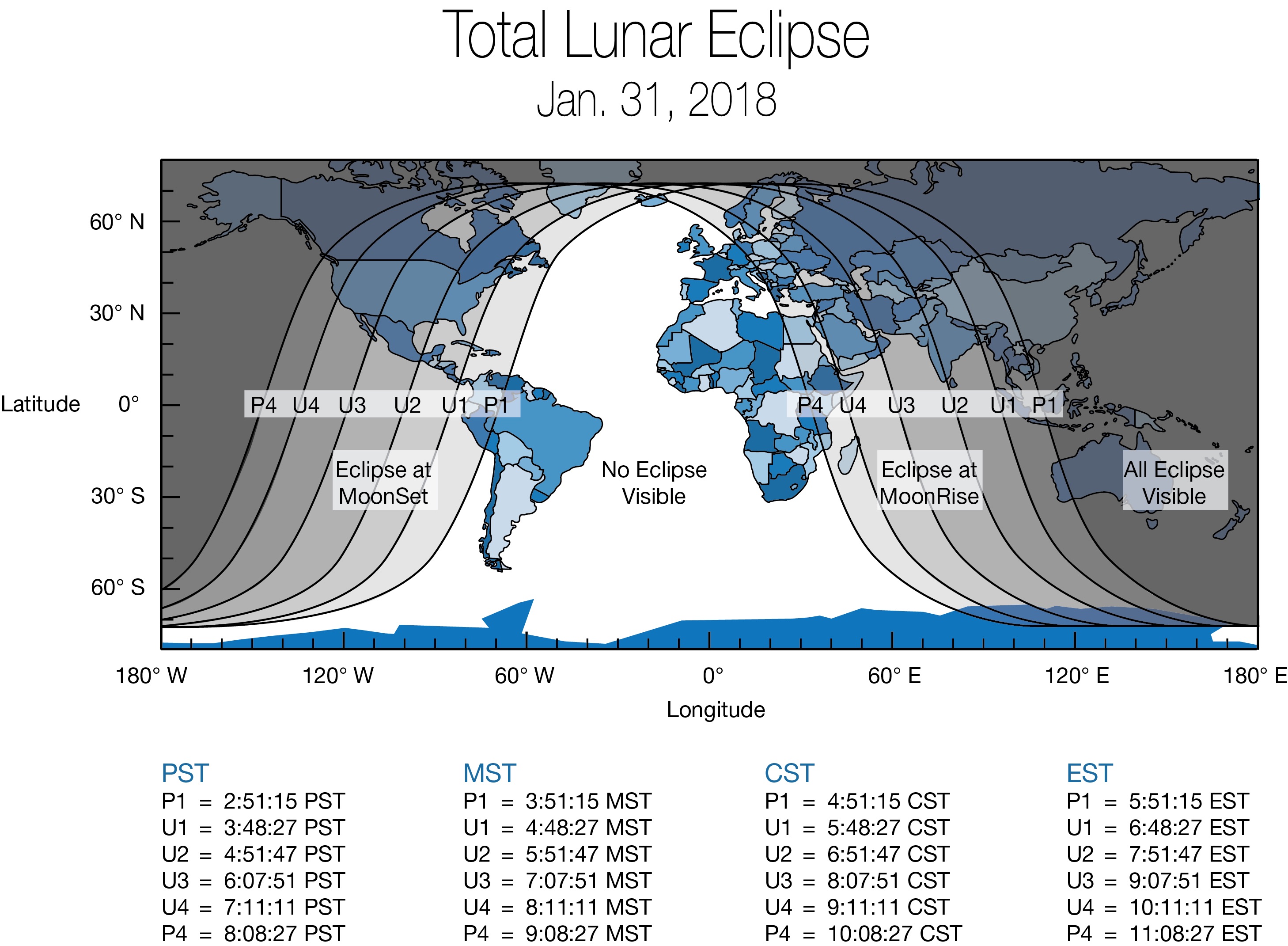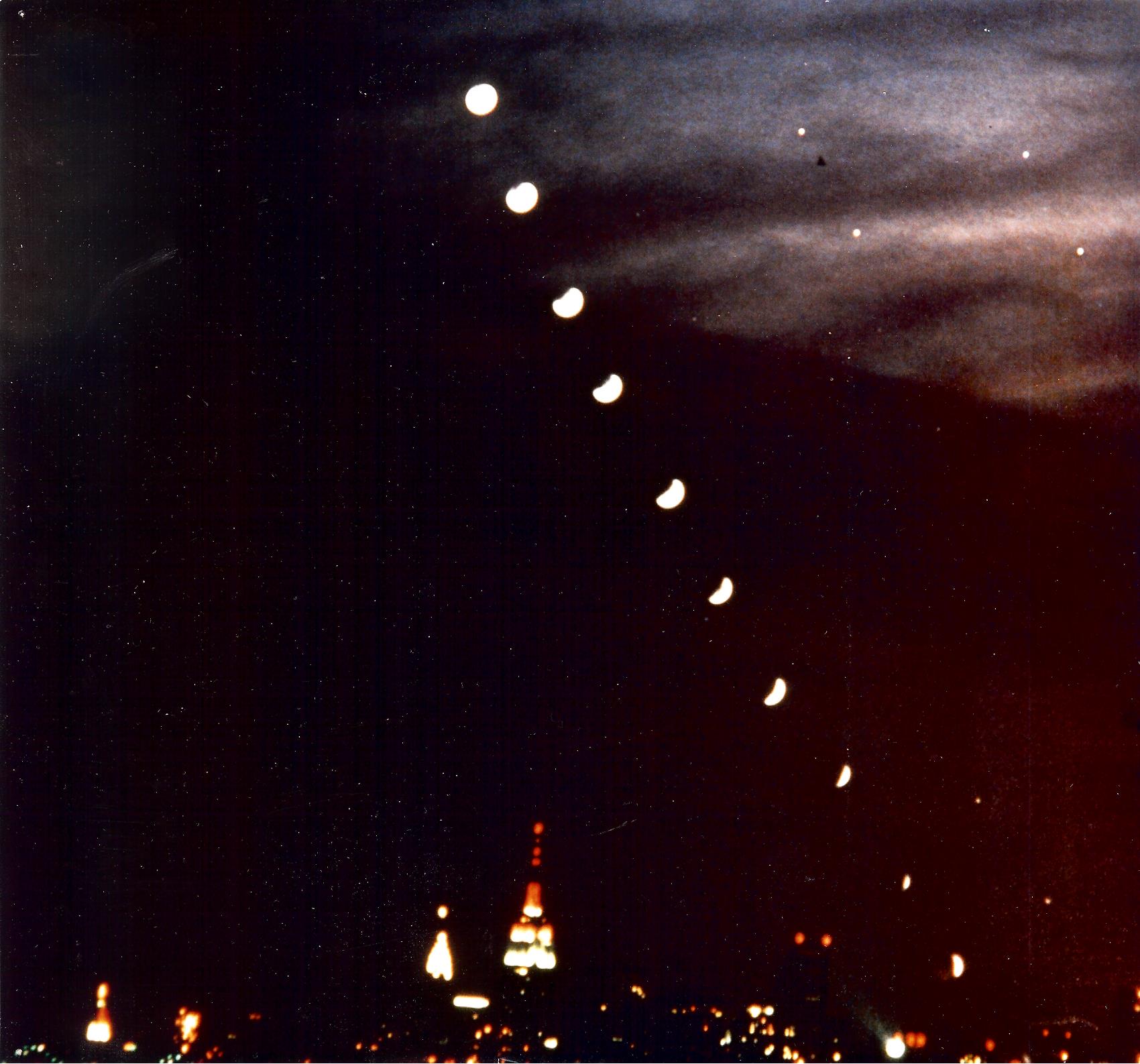How to See the 2018 Super Blue Blood Moon From the East Coast
In last week's Night Sky column, we previewed next Wednesday's total eclipse of the moon, putting a special emphasis on the total phase of the eclipse, which will last, at most, for 76 minutes, depending on your viewing location. Some viewers will have to make special preparations to view this eclipse, however, since it will also coincide with local moonset. This week, we'll concentrate on this unusual aspect.
Editor's note: The best places to see the eclipse, which NASA is calling the Super Blue Blood Moon, will be on the U.S. West Coast, Alaska and Hawaii. See our Super Blue Blood Moon best viewing places guide here.
A strange moonset

Observers across the central and eastern United States and Canada should pay particular attention to the setting full moon at or shortly before sunrise on Wednesday morning (Jan. 31), for the lunar eclipse will still be in progress. For North Americans, the farther west you go, the better the view; as the sun rises in the east-southeast sky, the moon will be going down on the opposite side of the sky in the west-northwest. [Super Blue Blood Moon 2018: When, Where and How to See It]
An interesting observation to attempt is to try and see the partially eclipsed setting moon and the rising sun simultaneously. The little-used name for this effect is a "selenelion" (or "selenehelion"). During a total lunar eclipse, the Earth lies directly between the moon and the sun, so observing both the sun and the moon in the sky might seem impossible, but remember that, thanks to our atmosphere, the images of both sun and moon are "lifted" above the horizon by atmospheric refraction. This allows us to see the sun for several extra minutes before it actually has risen and the moon for several extra minutes before it actually sets. You can read more about this phenomenon here.
Along the West Coast of the U.S., the total phase begins at 4:51 a.m. PST. The farther east you go, the closer the start of the partial phases will coincide with moonset. Along the U.S. Atlantic Seaboard, for instance, the moon will have only just begun to enter Earth's umbra (at 6:48 a.m. EST) when it will disappear from view below the west-northwest horizon.
To put it another way — if you live anywhere to the east of a line running from Flint, Michigan, south-southwest to New Orleans, Louisiana, the moon will set before the moon becomes completely enveloped in the Earth's shadow. Instead, viewers will see the moon set while it's in partial eclipse. The farther east you go, the percentage of the moon inside the umbra at moonset will shrink.
Get the Space.com Newsletter
Breaking space news, the latest updates on rocket launches, skywatching events and more!
Consolation prize: partial coverage
For those living in the eastern U.S. as well as eastern Canada, the moon's initial entrance into the umbra will be the main spectacle. Below I have provided a timetable, which gives the time of moonset for 12 selected cities and how much of the moon's diameter will be eclipsed by Earth's dark shadow at that moment. All times are EST.
| Boston, MA | 6:58 a.m. | 16 |
| Lewiston, ME | 6:59 a.m. | 17 |
| Miami, FL | 7:04 a.m. | 25 |
| New York, NY | 7:06 a.m. | 29 |
| Washington, DC | 7:15 a.m. | 43 |
| Montreal, QC | 7:17 a.m. | 46 |
| Pittsburgh, PA | 7:31 a.m. | 68 |
| Atlanta, GA | 7:35 a.m. | 75 |
| Toronto, ON | 7:36 a.m. | 76 |
| Chattanooga, TN | 7:41 a.m. | 84 |
| Cincinnati, OH | 7:46 a.m. | 92 |
| Louisville, KY | 7:50 a.m. | 98 |
For artists and astrophotographers, the low, partially eclipsed moon in deep-blue twilight should offer a wide variety of interesting scenic possibilities. Over the Ohio Valley, south to the Gulf Coast, a peculiar-looking waxing crescent moon will appear to drop toward the west-southwest horizon. Aormally, you would not expect to see a crescent moon setting in the west at dawn, and the crescent will appear oriented such that the cusps or "horns" will be pointed almost straight up, as if the moon were a boat or a cup holding water. Farther east, along the Atlantic Seaboard, the moon will appear to be notched on its upper-left side by the shadow.
Depending on the clarity of your sky, however, you might have to forfeit perhaps up to 15 minutes of eclipse viewing time prior to sunrise: As the dawn sky progressively brightens, visibility may be further reduced by the presence of a hazy horizon as the moon appears to slip lower in the sky. And keep in mind that this holds only for the uneclipsed portion of the moon.
Going still farther east, the moon will go down "full," but observers in eastern Maine and the Canadian Maritime Provinces might still be able to detect a stain on the moon's upper-left limb from the penumbra (Earth's outer shadow) if the west-northwest horizon is haze-free. It might look like the famous "Man in the Moon" has a bruise over his right eye. I’m interested in hearing from skywatchers who detect the penumbra on the setting moon. When you email me (skywayinc@aol.com), be sure to indicate your location and any instrument you might have used.

Just a shadow of its former self
The moon will set in the "total" phase across a 1,000-mile (1,600 kilometers) swath that will encompass the northern and central Great Plains, southern and western Great Lakes, and part of the Deep South, as well as all of Oklahoma and Texas, and eastern portions of both New Mexico and Colorado.
Indeed, if the moon will be totally eclipsed at moonset where you live, then it might be difficult for you to see the moon with the naked eye just before it dips below the horizon. You'll probably have to carefully scan the west-northwest horizon with binoculars as the twilight brightens in order to detect the moon, which will somewhat resemble a dim, sooty and eerily illuminated mottled softball.
From personal experience, I can recall an eclipse with somewhat similar circumstances: the total lunar eclipse of Dec. 30, 1982, which I observed with about 70 other astronomy aficionados from the West End No. 2 parking field at Jones Beach on Long Island, N.Y. The moon gradually slipped into Earth’s shadow as it descended the western sky, hitting totality just above the west-northwest horizon. Using a 35-millimeter Nikormat camera and high-speed film, I created a montage composed of 10 images of the fading moon, taken at 6-minute intervals. A day later, I went to Ferry Point Park in the Bronx and snapped a view of the Manhattan skyline and added it to the eclipse montage I had shot from the beach the previous day.
No worries for your eyes
Finally, don't worry about doing damage to your eyes. This is a lunar eclipse, not a solar eclipse. So unlike the precautions you had to take for safely viewing last summer’s "Great American Solar Eclipse," there will be absolutely no risk to your eyesight for this shady little drama at month's end.
Wherever you may be, good luck and clear skies!
Editor's note: If you captured an amazing photo of video of the Jan. 31 total lunar eclipse and would like to share it with Space.com for a story or gallery, send images and comments to: spacephotos@space.com.
Joe Rao serves as an instructor and guest lecturer at New York's Hayden Planetarium. He writes about astronomy for Natural History magazine, the Farmers’ Almanac and other publications, and he is also an on-camera meteorologist for Verizon Fios1 News, based in Rye Brook, NY. Follow us @Spacedotcom, Facebook and Google+. Original article on Space.com.
Join our Space Forums to keep talking space on the latest missions, night sky and more! And if you have a news tip, correction or comment, let us know at: community@space.com.

Joe Rao is Space.com's skywatching columnist, as well as a veteran meteorologist and eclipse chaser who also serves as an instructor and guest lecturer at New York's Hayden Planetarium. He writes about astronomy for Natural History magazine, Sky & Telescope and other publications. Joe is an 8-time Emmy-nominated meteorologist who served the Putnam Valley region of New York for over 21 years. You can find him on Twitter and YouTube tracking lunar and solar eclipses, meteor showers and more. To find out Joe's latest project, visit him on Twitter.









